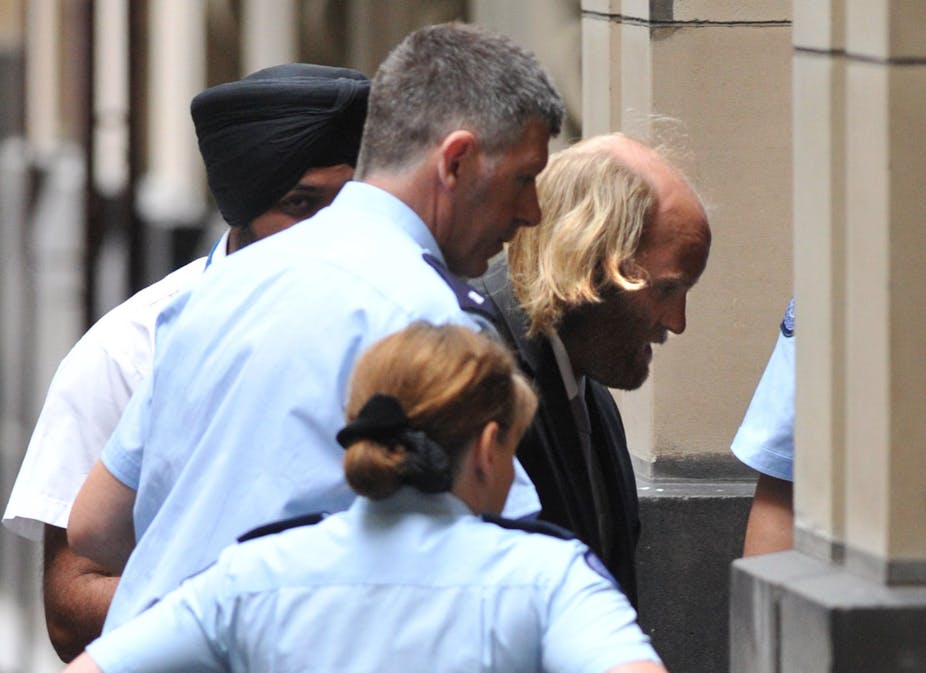Mad or bad, face of evil, addictions and tiger blood.
How well does the media report mental illness when these are descriptions and catchphrases taken from stories this year?
The answer is, it depends.
It would be hard to think of a more emotional case than the murder trial of Arthur Freeman.
Even talking about the circumstances is hard. A father drives his children to the West Gate Bridge, drops his young daughter over the side and returns with his sons to the court building where he had been arguing about their custody a day earlier.
In news terms, the perfect case.
The tragic death of a child in almost unthinkable circumstances stemming apparently from a bad result for a father in a custody battle.
Anger, horror and disbelief the prevailing emotions in a case that would disgust the public while attracting its interest.
As Victorian Chief Justice Marilyn Warren said in a speech last month, crime fascinated audiences, and economic pressures meant media companies were moving towards “tabloid-style” crime stories.
One United States study said focusing on a single case let the television networks provide “prolonged, detailed and relatively inexpensive coverage”.
More than a decade ago, the then British Lord Chancellor said he was increasingly concerned that economic and market pressures increasingly shaped the media filtering process.
News was a commodity, he said, with a cash value attached.
Added to this is research quoted on the Mindframe website, which educates and monitors reporting about mental health. Project manager Marc Bryant said the use of mental illness as a defence in murder cases was atypical. Drug and alcohol use had a stronger association with violence.
The Freeman case, mercifully, was exceptional. But even allowing for my bias as a former court reporter, it seemed readers could find serious coverage of the mental health issues if they read media reports of the trial. The stories were emotional, but they gave readers a reasonable picture of the psychiatric issues at trial.
Reporters were quick to use the barristers’ catchy phrases, like the submission by defence counsel David Brustman SC, that the jury had to find Freeman was “mad or bad” . In other words, guilty of murder (bad), or not guilty because he was mentally impaired (mad).
They described Freeman’s reactions in court, evidence by family members and witnesses to the horrific killing, and (after verdict) the faltering voice of Darcey’s mother, Peta Barnes, as she tried to read her victim impact statement.
After trial, one story suggested Freeman’s wild “mad monk” haircut (a prosecution description) was part of a ruse to make him look crazy. Another related a moment of empathy between Arthur Freeman’s father and trial judge, Justice Paul Coghlan, both grandfathers who understood the loss of a child.
Expert evidence about Freeman’s mental condition was crucial, and was contained in numerous stories from the hearing.
According to the reports, the defence case claimed Freeman had been in a dissociative state when he killed, likening him to someone who sleepwalked and could not remember what he had done.
A psychiatrist called by the prosecution agreed that the facts were consistent with spousal revenge.
Reading from her report on Freeman, the doctor said: “It is possible that Mr Freeman was in a state of dissociation some or all of the time on the day of the alleged offence. This does not mean his actions were not conscious or voluntary.”
Journalists were able to write more freely when Freeman was convicted of murder, but most post-trial coverage showed some restraint.
Some stories looked at child protection, other decried vengeful fathers.
A Herald Sun headline titled “The Man Behind the Monster” masked a story which produced a comprehensive summary of the case and outlined the psychiatric arguments.
As a piece of sensationalism, it failed. It even contained a brief explanation of the way the law defines sanity, and showed the “monster” tag was a cruel childhood nickname for Freeman.
Mental health reporting on celebrities seems to follow different rules. Footballer Brendan Fevola has admitted his various problems on television. For much of the last month, journalists have chased him from Los Angeles to Berwick as he tries to restart his career and fight his gambling addiction.
His rehabilitation was reported in detail. Even when he had to change clinics during the Queensland floods, readers learned of his relocation, and that he was walking barefoot through clinic halls.
To be fair, some stories have been educational. One report told the public what happens in rehabilitation. Others have featured helpline telephone numbers.
But we have to ask how many times Fevola needs to be photographed secretly at gaming venues. What if he goes to bingo?
The last word might go be left to actor Charlie Sheen, who seems to be demonstrating his mental health problems on Twitter, television and the stage.
Reportedly using terms like tiger blood, Adonis DNA and fire-breathing fists, Sheen is touring with his girlfriends in a stage show that followed his axing from network television.
The Huffington Post said he was booed when his rants and question-and-answer segment were not entertaining enough.
“Come on guys, you paid to see me,” he reportedly said. “You gave me your hard-earned money without knowing what this (expletive) show was about. I’m here now…and I’m willing to open up.”

